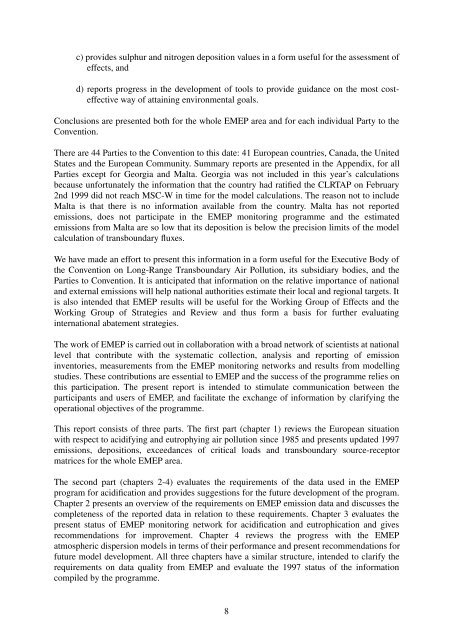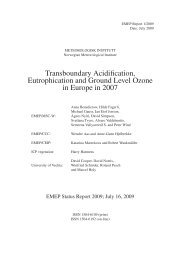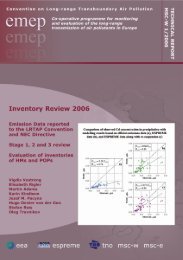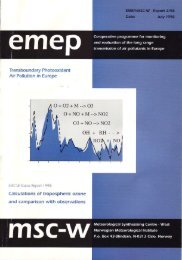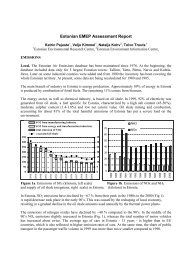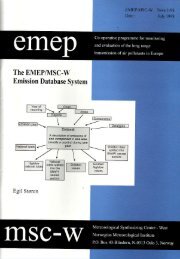ccc & msc-w - EMEP
ccc & msc-w - EMEP
ccc & msc-w - EMEP
Create successful ePaper yourself
Turn your PDF publications into a flip-book with our unique Google optimized e-Paper software.
c) provides sulphur and nitrogen deposition values in a form useful for the assessment of<br />
effects, and<br />
d) reports progress in the development of tools to provide guidance on the most costeffective<br />
way of attaining environmental goals.<br />
Conclusions are presented both for the whole <strong>EMEP</strong> area and for each individual Party to the<br />
Convention.<br />
There are 44 Parties to the Convention to this date: 41 European countries, Canada, the United<br />
States and the European Community. Summary reports are presented in the Appendix, for all<br />
Parties except for Georgia and Malta. Georgia was not included in this year’s calculations<br />
because unfortunately the information that the country had ratified the CLRTAP on February<br />
2nd 1999 did not reach MSC-W in time for the model calculations. The reason not to include<br />
Malta is that there is no information available from the country. Malta has not reported<br />
emissions, does not participate in the <strong>EMEP</strong> monitoring programme and the estimated<br />
emissions from Malta are so low that its deposition is below the precision limits of the model<br />
calculation of transboundary fluxes.<br />
We have made an effort to present this information in a form useful for the Executive Body of<br />
the Convention on Long-Range Transboundary Air Pollution, its subsidiary bodies, and the<br />
Parties to Convention. It is anticipated that information on the relative importance of national<br />
and external emissions will help national authorities estimate their local and regional targets. It<br />
is also intended that <strong>EMEP</strong> results will be useful for the Working Group of Effects and the<br />
Working Group of Strategies and Review and thus form a basis for further evaluating<br />
international abatement strategies.<br />
The work of <strong>EMEP</strong> is carried out in collaboration with a broad network of scientists at national<br />
level that contribute with the systematic collection, analysis and reporting of emission<br />
inventories, measurements from the <strong>EMEP</strong> monitoring networks and results from modelling<br />
studies. These contributions are essential to <strong>EMEP</strong> and the success of the programme relies on<br />
this participation. The present report is intended to stimulate communication between the<br />
participants and users of <strong>EMEP</strong>, and facilitate the exchange of information by clarifying the<br />
operational objectives of the programme.<br />
This report consists of three parts. The first part (chapter 1) reviews the European situation<br />
with respect to acidifying and eutrophying air pollution since 1985 and presents updated 1997<br />
emissions, depositions, exceedances of critical loads and transboundary source-receptor<br />
matrices for the whole <strong>EMEP</strong> area.<br />
The second part (chapters 2-4) evaluates the requirements of the data used in the <strong>EMEP</strong><br />
program for acidification and provides suggestions for the future development of the program.<br />
Chapter 2 presents an overview of the requirements on <strong>EMEP</strong> emission data and discusses the<br />
completeness of the reported data in relation to these requirements. Chapter 3 evaluates the<br />
present status of <strong>EMEP</strong> monitoring network for acidification and eutrophication and gives<br />
recommendations for improvement. Chapter 4 reviews the progress with the <strong>EMEP</strong><br />
atmospheric dispersion models in terms of their performance and present recommendations for<br />
future model development. All three chapters have a similar structure, intended to clarify the<br />
requirements on data quality from <strong>EMEP</strong> and evaluate the 1997 status of the information<br />
compiled by the programme.<br />
8


